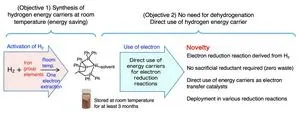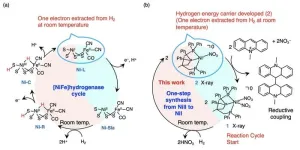(Press-News.org) The industrial whaling of the 19th and 20th centuries almost wiped out several species. However, even though whaling took place on a much smaller scale before this period, it was enough for at least two species to disappear completely from European waters.
These two species used to be among the most common, but now one of these species is on the verge of extinction.
“Whaling was widespread from a very early time. This had major consequences for species in Europe,” says Youri van den Hurk, a former postdoctoral fellow at the Norwegian University og Science and Technology (NTNU) University Museum.
Studying whale bones
A group of archaeologists examined 719 whale bones from various museum collections in Europe. Most of the whale bones originated from around 900 BCE to 1500 CE.
By studying the proteins in this bone material, it is often possible to find out which species these bones originated from. Youri van den Hurk carried out much of the analysis work at the NTNU University Museum.
The whale bones examined originated from whales caught as far north as Norway and as far south as Spain. Whaling was practised by people from many European countries, both in Scandinavia and the British Isles, but also in Belgium, France and Spain.
Coastal species disappeared first
It is perhaps not surprising that whaling was so widespread. Everything from a whale weighing several tonnes had a use.
Meat and blubber were eaten, whale oil was used to light lamps, and whale bones were made into everything from corsets to houses to trinkets. There were many products.
“Historical sources show that the earliest whalers used harpoons with buoys attached to them. This enabled them to tire the animals out before using spears and lances to kill them. However, the methods may have varied from place to place. Sources from Norway mention that spears tipped with poison were used, or that hunters cornered whales by chasing them into fjords,” says van den Hurk.
During the most intensive period, however, whalers occasionally caught so many whales that they only took the most valuable parts. The rest was left to rot.
In the 19th Century, larger whaling ships and more efficient equipment made it possible to catch more and larger whales in less time. Even the gigantic blue whale and fin whale could now be caught.
Modern ships enabled whalers to travel to distant regions of the Arctic and Antarctic. Norwegians Erik Eriksen and Svend Foyn’s grenade harpoon was particularly effective, and management of the whale stocks was usually very poor.
Both of the species that disappeared early from Europe are whales that stay close to the shore. This means it was possible for people in small boats and with ordinary harpoons to hunt them, even before whaling became a major industry. These whales were therefore particularly vulnerable, even though whaling was taking place on a very small scale.
“We know little about the aims and scope of this pre-industrial whaling. However, archaeology and historical sources give us a valuable opportunity to find out more about this early whaling,” says van den Hurk.
The grey whale survived in the Pacific Ocean
The grey whale (Eschrichtius robustus) is one of the species from which scientists find a lot of bones in their material. One of the bones is from Trondheim.
“The large prevalence surprised us, because grey whale bones have not been commonly identified in such large numbers during previous studies,” says Professor James H. Barrett, a professor at the Department of Archaeology and Cultural History.
The grey whale started disappearing from parts of the North Atlantic as early as the Middle Ages, and the species was completely gone from the area by the 18th Century. The species currently has two viable populations in the Pacific Ocean, but it has not yet returned to the Atlantic with the exception of the occasional stray.
Despite us no longer seeing grey whales along the Norwegian coast or elsewhere in Europe, the species survived in areas where whaling was not that common at the time.
Another species fared a lot worse, however, and the scientists knew about the problems it faced before this study got underway.
The North Atlantic right whale is still struggling
The North Atlantic right whale (Eubalaena glacialis) is a slow swimmer that prefers to stay close to the shore. In addition, the species has a large amount of blubber, which keeps it afloat on the surface of the water when killed.
“The species is therefore relatively easy prey for whalers. This is probably why North Atlantic right whale bones make up most of the material we find,” says Professor Barrett.
North Atlantic right whales were widespread along the coast of Europe until the 18th Century, but have hardly been hunted since the 19th Century because so few of them were left. Today, North Atlantic right whales are probably extinct in the eastern Atlantic, and hardly any of them are left in the western Atlantic. The species is in serious trouble.
North Atlantic right whales have been completely protected since 1937, but despite this, only 300–400 individuals remain. These are mostly found along the coast of North America.
Today, whaling no longer poses a threat to North Atlantic right whales. However, in a world of eight billion people, these are not good times for a species that lives in coastal areas where there is a lot of shipping traffic.
Several species are almost extinct
During the course of 70 years, 1.3 million whales were killed in Antarctica alone. Whaling declined after the 1960s because whales became scarce and hunting them was no longer profitable.
The blue whale, once common in Norway, is a famous example of how wrong things went. One of the only places in Norwegian waters where blue whales can be seen today is off the coast of Jan Mayen, and these sightings are very rare.
Approximately 300,000 blue whales could be found in Antarctica before the onset of modern whaling. Although the species was protected as early as 1966, ships from the Soviet Union continued to hunt it for a long time. Currently, there are certainly no more than 25,000 blue whales left in the world, perhaps as few as 10,000, divided into several subspecies.
A total ban on whaling was only introduced in 1982. Despite this prohibition, Norway, Japan and Iceland continue their whaling activities, with Japan and Norway often citing research as an alibi.
Norwegian whalers have killed at least 15,000 minke whales since 1982, but the local population amounts to approximately 100,000 animals and is not considered endangered. Despite the prevalence of this species, this whaling sometimes sparks strong criticism from other countries.
Norwegian whaling is currently very limited, but whale meat is still a common sight in Norwegian freezer counters.
Can the grey whale make a comeback?
We can certainly learn something from these findings.
“What I find particularly interesting and useful is that the grey whale and North Atlantic right whale were so widespread in Europe, perhaps the most common groups we had, and both were completely eradicated locally,” says van den Hurk.
However, lone grey whales have been spotted again in Europe. Could it be that the species is making a comeback?
“Climate change has led to the Northwest Passage being ice-free for longer periods than previously. This makes it possible for grey whales to return to the North Atlantic. The Northwest Passage is the sea route between Asia and Europe, located to the north of North America. Seeing as we now know where the species used to be prevalent, we also know which areas we need to protect if the grey whale ever returns,” says van den Hurk.
International collaboration
The work was led by NTNU, but has been carried out in collaboration with the University of Cambridge, the University of Oviedo, the University of Groningen, Leiden University, the University of York, the University of Rennes, Accueil Ecole, Oniris and the Arctic University Museum of Norway. The results have now been presented in the Royal Society Open Science journal.
The research was funded by the European Research Council (ERC), the EU’s Horizon 2020 programme and the Royal Netherlands Academy of Arts and Sciences.
References: Van den Hurk Y et al. 2023 The prelude to industrial whaling: identifying the targets of ancient European whaling using zooarchaeology and collagen mass-peptide fingerprinting. R. Soc. Open Sci. 10: 230741. https://doi.org/10.1098/rsos.230741
END
Early whaling eradicated species from local waters
The right whale and grey whale were eliminated from the eastern Atlantic centuries before the age of industrial whaling began
2023-10-26
ELSE PRESS RELEASES FROM THIS DATE:
Fungi used in food production could lead to new probiotics
2023-10-26
Washington, D.C. — Many fungus strains have been used and selected by the food industry for their capacities to ferment, produce flavors or produce heterologous molecules. According to a new study, 2 fungi used to produce food products have potential probiotic effects on gut inflammation. The study, published in mSystems, a journal of the American Society for Microbiology, demonstrates a possible new way to develop new probiotics.
“There is much to learn by studying the role of the ...
A potentially cheaper and 'cooler' way of hydrogen transport
2023-10-26
Fukuoka, Japan—In the continued effort to move humanity away from fossil fuels and towards more environmentally friendly energy sources, researchers in Japan have developed a new material capable storing hydrogen energy in a more efficient and cheaper manner. The new hydrogen energy carrier can even store said energy for up to three months at room temperature. Moreover, since the material is nickel based, its cost is relatively cheap. The results were reported in Chemistry—A European Journal.
As humanity combats the ongoing climate crisis, ...
New guide details menopause’s effects on the workplace, other surprising impacts
2023-10-26
A sweeping new guide to menopause by a UVA Health expert and collaborators highlights the profound and sometimes surprising effects the “change of life” can have on women’s lives, health, workplaces and even finances.
The paper represents a holistic review of what we know about menopause and what we still need to learn. While it is directed primarily at doctors and scientists, it offers fascinating insights into how menopause affects American women and women worldwide.
According to article co-author JoAnn V. Pinkerton, MD, UVA Health's director of midlife health, such insights represent ...
Mount Sinai renames top-ranked heart hospital to honor Valentin Fuster, MD, PhD, and his legacy of excellence
2023-10-26
Mount Sinai Health System announced today that “Mount Sinai Fuster Heart Hospital” is the new name for its top-ranked heart service, formerly known as Mount Sinai Heart. The renaming honors Valentin Fuster, MD, PhD, Physician-in-Chief of The Mount Sinai Hospital and President of the Fuster Heart Hospital, for the immeasurable impact that he has made and will continue to make on the field of cardiology and his leadership at Mount Sinai.
Over the last 25 years, Dr. Fuster has transformed Mount Sinai’s heart service into a world-leading center for cardiovascular disease, providing exceptional and compassionate care for cardiac patients, new and innovative ...
Mount Sinai receives $4.6 million from Pershing Square Foundation to support women’s health research and careers for women in science
2023-10-26
(New York, NY – October 26, 2023) – The Icahn School of Medicine at Mount Sinai has received a $4.6 million gift from the Pershing Square Foundation to support women’s health research and advance careers for female scientists. Part of an original nearly $21 million gift that expanded a COVID-19 testing program for New York City schools and other organizations, this boost in women-focused initiatives connects the Pershing Square Foundation’s interest in supporting women in science to Mount Sinai’s leading researchers and key initiatives ...
Case Western Reserve University researcher awarded $3.5 million federal grant
2023-10-26
CLEVELAND—A researcher from the Case Western Reserve University Frances Payne Bolton School of Nursing has been awarded a $3.5 million federal grant for research to improve sleep health and glucose management in young adults with type 1 diabetes.
Positive findings could lead to adding the intervention in current care protocols. The ultimate goal is to improve outcomes for a population that struggles to maintain blood-sugar (glycemic) targets, compared to other age groups.
“Young adults with type 1 diabetes are a high-risk group, and I am committed to improving their ...
Study aims to include truckers when redefining trucking in the age of automated vehicles
2023-10-26
AMHERST, Mass. — Last year, trucks moved 73%—11.5 billion tons—of the freight in the U.S., making trucks—and truckers—crucial to the U.S. economy. With automation in trucking projected to grow 22% over the next 10 years, a team of University of Massachusetts Amherst researchers has received a grant to explore how automation will affect the role of American long-haul truckers.
An interdisciplinary group of researchers led by Shannon Roberts, associate professor of mechanical and industrial engineering, has been awarded nearly $2 million over four years by the National Science Foundation’s (NSF) Future of Work Program.
“We know ...
An unexpected link between 2 schizophrenia risk proteins
2023-10-26
COLUMBUS, Ohio – The discovery of a physical interaction between two proteins in brain cells that can be traced in mice to control of movement, anxiety and memory could one day open the door to development of new schizophrenia treatment strategies, researchers say.
The research group is the first to determine that the two proteins, both among the dozens of proteins related to risk for the development of schizophrenia, bind to each other under normal conditions in multiple regions of the brain, ...
ERC Synergy Grants back 37 teams to tackle complex scientific questions
2023-10-26
Thirty-seven research groups will receive €395 million in total to address some of the world’s most formidable research problems spanning a range of scientific disciplines. The funding helps groups of outstanding researchers to pool different skills, knowledge and resources to push the frontiers of our knowledge. The ERC Synergy Grant scheme is part of the EU's research and innovation programme, Horizon Europe.
Iliana Ivanova, Commissioner for Innovation, Research, Culture, Education and Youth, said: “Some scientific questions are too complex to be addressed by researchers working on their own. Challenges such as climate change or ...
New research reveals alarming privacy and security threats in Smart Homes
2023-10-26
An international team of researchers, led by IMDEA Networks and Northeastern University in collaboration with NYU Tandon School of Engineering, Universidad Carlos III de Madrid, IMDEA Software, University of Calgary, and the International Computer Science Institute, has unveiled groundbreaking findings on the security and privacy challenges posed by the ever-growing prevalence of opaque and technically complex Internet of Things (IoT) devices in smart homes.
Smart Homes: Trusted and Secure Environments?
Smart homes are becoming increasingly interconnected, ...
LAST 30 PRESS RELEASES:
New expert guidance urges caution before surgery for patients with treatment-resistant constipation
Solar hydrogen can now be produced efficiently without the scarce metal platinum
Sleeping in on weekends may help boost teens’ mental health
Study: Teens use cellphones for an hour a day at school
After more than two years of war, Palestinian children are hungry, denied education and “like the living dead”
The untold story of life with Prader-Willi syndrome - according to the siblings who live it
How the parasite that ‘gave up sex’ found more hosts – and why its victory won’t last
When is it time to jump? The boiling frog problem of AI use in physics education
Twitter data reveals partisan divide in understanding why pollen season's getting worse
AI is quick but risky for updating old software
Revolutionizing biosecurity: new multi-omics framework to transform invasive species management
From ancient herb to modern medicine: new review unveils the multi-targeted healing potential of Borago officinalis
Building a global scientific community: Biological Diversity Journal announces dual recruitment of Editorial Board and Youth Editorial Board members
Microbes that break down antibiotics help protect ecosystems under drug pollution
Smart biochar that remembers pollutants offers a new way to clean water and recycle biomass
Rice genes matter more than domestication in shaping plant microbiomes
Ticking time bomb: Some farmers report as many as 70 tick encounters over a 6-month period
Turning garden and crop waste into plastics
Scientists discover ‘platypus galaxies’ in the early universe
Seeing thyroid cancer in a new light: when AI meets label-free imaging in the operating room
Neutrophil-to-lymphocyte ratio may aid risk stratification in depressive disorder
2026 Seismological Society of America Annual Meeting
AI-powered ECG analysis offers promising path for early detection of chronic obstructive pulmonary disease, says Mount Sinai researchers
GIMM uncovers flaws in lab-grown heart cells and paves the way for improved treatments
Cracking the evolutionary code of sleep
Medications could help the aging brain cope with surgery, memory impairment
Back pain linked to worse sleep years later in men over 65, according to study
CDC urges ‘shared decision-making’ on some childhood vaccines; many unclear about what that means
New research finds that an ‘equal treatment’ approach to economic opportunity advertising can backfire
Researchers create shape-shifting, self-navigating microparticles
[Press-News.org] Early whaling eradicated species from local watersThe right whale and grey whale were eliminated from the eastern Atlantic centuries before the age of industrial whaling began





